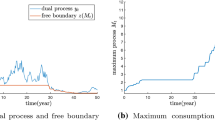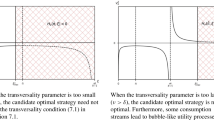Abstract
We develop envelope theorems for optimization problems in which the value function takes values in a general Banach lattice. We consider both the special case of a convex choice set and a concave objective function and the more general case case of an arbitrary choice set and a general objective function. We apply our results to discuss the existence of a well-defined notion of marginal utility of wealth in optimal discrete-time, finite-horizon consumption-portfolio problems with an unrestricted information structure and preferences allowed to display habit formation and state dependency.
Similar content being viewed by others
Notes
One can for instance take \(Y=L^{p}\) for some \(p\ge 1\). If the set \(\left( F(\theta ,u)\right) _{\theta \in \varTheta }\) is bounded from above in \(L^{q}\) with \(q<p\) but not in \(L^{p}\), then \(V(u)\in L^{q}\) but it does not belong to \(L^{p}\).
\(B(u^*,r)\) denotes as usual the open ball with center \(u^*\) and radius \(r\).
In an order complete Banach lattice, the norm convergence is equivalent to relative uniform star convergence, which in turn implies order convergence. As a consequence, if a sequence \(x_{n}\) converges in norm to \(x\) , then there exist a subsequence which is order convergent to \(x\) (see Birkhoff [4], Chap. 15, Theorems 19 and 20).
Similar requirements of equi-differentiability with respect to the choice parameter and of boundedness of the derivative of \(F\) are made by Milgrom and Segal [14] to obtain the continuity and the differentiability of the value function for the case in which the objective function takes values in \(\mathfrak {R}\).
The function \(u{:}\mathfrak {R}^{t+1} {\rightarrow } \mathfrak {R}\) is strictly increasing if \(u(c_0, \ldots , c_t) > u(\tilde{c}_0, \ldots , \tilde{c}_t)\) for every pair \((c_s)_{0\le s \le t}, (\tilde{c}_s)_{0\le s \le t}\) such that \(c_s \ge \tilde{c}_s\) for all \(s\) and \(c_{\bar{s}} > \tilde{c}_{\bar{s}}\) for at least one \(\bar{s}\).
Existence and uniqueness of such a random variable are guaranteed by Riesz representation theorem (see also Duffie and Skiadas [10] for the definition of state-price densities by the Riesz representation property of the utility gradient).
An example is the standard money market account.
References
Aliprantis, C.D., Border, K.C.: Infinite Dimensional Analysis: A Hitchhiker’s Guide. Springer, Berlin (1999)
Battauz, A., De Donno, M., Ortu, F.: Intertemporal asset pricing and the marginal utility of wealth. J. Math. Econ. 47(2), 227–244 (2011)
Benveniste, L.M., Scheinkman, J.A.: On the differentiability of the value function in dynamic models of economics. Econometrica 47(3), 727–732 (1979)
Birkhoff, G.: Lattice theory, American Mathematical Society Colloquium Publications, vol. 25. American Mathematical Society, Providence (1967)
Bonnans, J.F., Shapiro, A.: Perturbation Analysis of Optimization Problems. Springer, New York (2000)
Borwein, J.M.: Continuity and differentiability properties of convex operators. Proc. Lond. Math. Soc. 44, 420–444 (1982)
Campbell, J.Y., Cochrane, J.H.: By force of habit: a consumption-based explanation of aggregate stock market behavior. J. Polit. Econ. 2, 205–251 (1999)
Cruz-Suárez, H., Montes-de-Oca, R.: An envelope theorem and some applications to discounted Markov decision processes. Math. Methods. Oper. Res. 67, 299–321 (2008)
Duffie, D.: Dynamic Asset Pricing Theory, 3rd edn. Princeton University Press, Princeton, NJ (2001)
Duffie, D., Skiadas, C.: Continuous-time security pricing: a utility gradient approach. J. Math. Econ. 23(2), 107–131 (1994)
Follmer, H., Schied, A.: Stochastic Finance: an Introduction in Discrete Time. de Gruyter, Berlin (2002)
Lindenstrauss, J., Preiss, D.: On Fréchet differentiability of Lipschitz maps between Banach spaces. Ann. Math. 157, 257–288 (2003)
Luenberger, D.G.: Optimization by vector space methods. John Wiley and Sons, New York (1969)
Milgrom, P., Segal, I.: Envelope theorems for arbitrary choice sets. Econometrica 70(2), 583–601 (2002)
Morand, O., Reffet, K., Tarafdar, S.: A non smooth approach to Envelope Theorems. Discussion Paper 11–03, Indian Statistical Institute, Delhi (2011)
Papageorgiou, N.: Nonsmooth analysis on partially ordered vector spaces: Part I—convex case. Pac. J. Math. 107(2), 403–458 (1983a)
Papageorgiou, N.: Nonsmooth analysis on partially ordered vector spaces: Part II—nonconvex case, Clarke’s theory. Pac. J. Math. 109(2), 463–495 (1983b)
Rincón-Zapatero, J.P., Santos, M.S.: Differentiability of the value function without interiority assumptions. J. Econ. Theory 144(5), 1948–1964 (2009)
Rockafellar, R.T.: Convex Analysis. Princeton University Press, Princeton, NJ (1970)
Skiadas, C.: Asset Pricing Theory. Princeton University Press, Princeton, NJ (2009)
Valadier, M.: Sous différentiabilité de fonctions convexes à valeurs dans un espace vectoriel ordonné. Math. Scand. 30, 65–74 (1972)
Author information
Authors and Affiliations
Corresponding author
Differentiability and concavity in normed vector spaces
Differentiability and concavity in normed vector spaces
In this section we summarize the main definition and results for cone-concave functions on vector spaces and, in particular, on the relation between concavity and differentiability. Let \(X\), \(Y\) be normed vector spaces and \(G\) a mapping defined on an open domain \(U\subset X\), with values in \(Y\).
Definition 4
We say that \(G\) admits derivative at a point \(u\in U\) in a direction \(x\in X\) if the limit:
exists, where the limit is meant in \(Y\)-norm.
The function \(G\) is said to be Gateaux differentiable at \(u\) if it is directional differentiable at \(u\) in every direction \(x\in X\) and the directional derivative \(G^{\prime }(u;\, \cdot \,):X\rightarrow Y\) is a continuous and linear operator. In this case, we denote this operator with \(DG(u)\) (namely, \(DG(u)(x) = G^{\prime }(u;x)\)) and call it the Gateaux differential of \(G\) at \(u\).
Definition 5
We say that \(G\) is Fréchet-differentiable at \(u\) if there exists a continuous and linear operator \(DG(u):X\rightarrow Y\) such that
The operator \(DG(u)\) is called the Fréchet differential of \(G\) at \(u\).
The results which follow can be found in [6, 16, 21]. Usually, definition and results are stated for convex function. Since we work under a concavity assumption, we reformulated them in the appropriate form for concave functions with values in the order complete Banach lattice \( (Y,C,\ge ),\) where \(C\) is the positive cone of \(Y\).
Definition 6
A function \(F:X \rightarrow Y\) is \(C\) -concave (or simply concave) if for all \(x,y\in X\), \(\lambda \in [0,1]\)
namely, \(F(\lambda x + (1-\lambda ) y) - \lambda F(x) + (1-\lambda ) F(y) \in C \).
The sets of points at which \(F\) is finite is called the essential domain of \(F\) and denoted by \(domF\). The algebraic interior of \(F\) is denoted \(coreF\).
Proposition 8
(Borwein [6], Proposition 2.3) Let \(G:X \rightarrow \bar{Y}\) be concave. Assume that there exists a function \(F:X \rightarrow \bar{Y}\) such that \( G(x) \ge F(x)\) for all \(x\in X\). If \(F\) is continuous at some point \(x_0 \in X\), then \(G\) is continuous at \(x_0\).
Let now \(\mathcal {L}(X,Y)\) denote the set of continous and linear operators between \(X\) and \(Y\) and let \(F\) be a concave function from \(X\) to \(\bar{Y}\).
Definition 7
An operator \(L\in \mathcal {L}(X,Y)\) is called a superdifferential for \(F\) at \(x_0\) if for all \(x \in X\)
The superdifferential set is denoted by \(\partial F(x_0)\).
Proposition 9
(Borwein [6], Proposition 3.2 (a) and Proposition 3.7 (a)) If \(F: X \rightarrow \bar{Y}\) is concave, with \(x_0 \in core F\), then
exists and is everywhere finite and superlinear.
Proposition 10
(Valadier [21], Proposition 4 and Théorème 6) If \( F:X \rightarrow \bar{Y}\) is concave and \(x_0 \in core F\) then:
-
(i)
\(L\in \mathcal {L}(X,Y)\) is a superdifferential for \(F\) at \(x_0\) if and only if \(L(x) \ge F^> (x_0,x)\) for all \(x \in X\);
-
(ii)
if in addition \(F\) is continuous at \(x_0\), then \(\partial F(x_0)\) is non-empty, convex and equicontinuous in \(\mathcal {L}(X,Y)\) and
$$\begin{aligned} F^> (x_0,x) = \min \{L(x): L \in \partial F(x_0)\}. \end{aligned}$$
Proposition 11
(Papageorgiou [16], Theorem 4.6) Let \(F:X \rightarrow \bar{Y}\) be a concave function. If \(F\) is continuous at \(x_0\), then \(F\) is Gateaux-differentiable at \(x_0\) if and only if \(\partial F(x_0)\) is a singleton.
Rights and permissions
About this article
Cite this article
Battauz, A., De Donno, M. & Ortu, F. Envelope theorems in Banach lattices and asset pricing. Math Finan Econ 9, 303–323 (2015). https://doi.org/10.1007/s11579-015-0145-5
Received:
Accepted:
Published:
Issue Date:
DOI: https://doi.org/10.1007/s11579-015-0145-5
Keywords
- Envelope theorem
- Banach lattice
- State-dependent utility
- Value function
- Gateaux differential
- Fréchet differential




